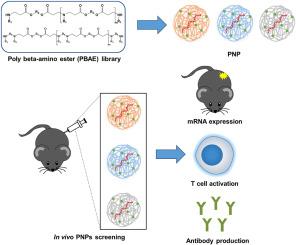用于递送 mRNA 的单体变化聚(β-氨基酯)聚合物库。
IF 12.8
1区 医学
Q1 ENGINEERING, BIOMEDICAL
引用次数: 0
摘要
用于递送 mRNA 的非病毒载体主要包括脂质纳米颗粒(LNPs)和聚合物。虽然 LNPs 以其高效的 mRNA 递送而著称,但它们可能会诱发过度的免疫反应并造成脱靶效应,从而可能导致副作用。在本研究中,我们旨在探索基于聚合物的 mRNA 递送系统,将其作为 LNPs 的可行替代品,重点关注其 mRNA 递送效率和在 mRNA 疫苗中的潜在应用。我们将各种胺单体和丙烯酸酯单体结合在一起,创建了一个聚(β-氨基酯)(PBAE)聚合物库。通过筛选这个聚合物库,我们确定了特定的聚合物纳米颗粒(PNPs),它们具有很高的 mRNA 表达效率,mRNA 表达可持续两周。此外,这些 PNPs 仅在注射部位显示 mRNA 表达,且不显示肝脏毒性。此外,在评估免疫激活时,PNPs 能显著诱导 T 细胞免疫激活,并在斑块减少中和试验中有效。这些结果表明,基于聚合物的 mRNA 递送系统不仅具有用于 mRNA 疫苗的潜力,而且在治疗应用方面也大有可为。本文章由计算机程序翻译,如有差异,请以英文原文为准。

Poly(β-amino ester) polymer library with monomer variation for mRNA delivery
Non-viral vectors for mRNA delivery primarily include lipid nanoparticles (LNPs) and polymers. While LNPs are known for their high mRNA delivery efficiency, they can induce excessive immune responses and cause off-target effects, potentially leading to side effects. In this study, we aimed to explore polymer-based mRNA delivery systems as a viable alternative to LNPs, focusing on their mRNA delivery efficiency and potential application in mRNA vaccines. We created a library of poly(β-amino ester) (PBAE) polymers by combining various amine monomers and acrylate monomers. Through screening this polymer library, we identified specific polymer nanoparticles (PNPs) that demonstrated high mRNA expression efficiency, with sustained mRNA expression for up to two weeks. Furthermore, the PNPs showed mRNA expression only at the injection site and did not exhibit liver toxicity. Additionally, when assessing immune activation, the PNPs significantly induced T-cell immune activation and were effective in the plaque reduction neutralization test. These results suggest that polymer-based mRNA delivery systems not only hold potential for use in mRNA vaccines but also show promise for therapeutic applications.
求助全文
通过发布文献求助,成功后即可免费获取论文全文。
去求助
来源期刊

Biomaterials
工程技术-材料科学:生物材料
CiteScore
26.00
自引率
2.90%
发文量
565
审稿时长
46 days
期刊介绍:
Biomaterials is an international journal covering the science and clinical application of biomaterials. A biomaterial is now defined as a substance that has been engineered to take a form which, alone or as part of a complex system, is used to direct, by control of interactions with components of living systems, the course of any therapeutic or diagnostic procedure. It is the aim of the journal to provide a peer-reviewed forum for the publication of original papers and authoritative review and opinion papers dealing with the most important issues facing the use of biomaterials in clinical practice. The scope of the journal covers the wide range of physical, biological and chemical sciences that underpin the design of biomaterials and the clinical disciplines in which they are used. These sciences include polymer synthesis and characterization, drug and gene vector design, the biology of the host response, immunology and toxicology and self assembly at the nanoscale. Clinical applications include the therapies of medical technology and regenerative medicine in all clinical disciplines, and diagnostic systems that reply on innovative contrast and sensing agents. The journal is relevant to areas such as cancer diagnosis and therapy, implantable devices, drug delivery systems, gene vectors, bionanotechnology and tissue engineering.
 求助内容:
求助内容: 应助结果提醒方式:
应助结果提醒方式:


